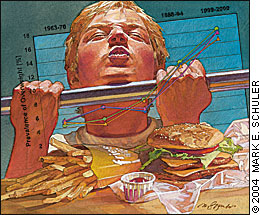
Am Fam Physician. 2004;69(11):2503

The illustration on the cover of this issue (above), by Mark E. Schuler, Prairie Village, Kan., shows the struggle that children face in maintaining physical fitness in a world filled with the temptations of fast foods and sedentary pleasures. Hamburgers and fries loom in front of the boy in this picture, who already is having difficulty doing the pull-ups required of a fitness program.
The cover article, by Angela Fowler-Brown, M.D., M.P.H., and Leila C. Kahwati, M.D., M.P.H., University of North Carolina at Chapel Hill, discusses the prevention and treatment of overweight in children and adolescents (page2591). The authors point out that 15 percent of children in the United States are at risk for overweight, while another 15 percent are already overweight. This represents triple the incidence of obesity 40 years ago. The incidence appears to be highest in Hispanic boys and adolescents and in black girls and adolescents.
The most common short-term effects of obesity in children are psychologic. The long-term consequences include an increased risk of coronary artery disease and arthritis in adulthood that is independent of their weight as adults, and an increased risk of obesity in adulthood. School-based interventions to prevent obesity in children generally are ineffective. Interventions that are tailored to the individual youngster and that involve the entire family seem to be most effective. Behavioral therapy, reduction in sedentary behavior, and nutrition and physical activity education are moderately effective interventions. Family physicians should identify children and adolescents who are at risk for overweight at an early stage and educate the entire family about the long-term health consequences of being overweight.
The “Medicine and Society” article on page2545 explores the effect of the mass media on health, including the impact of television on the development of obesity in children. The author, Brian A. Primack, M.D., Ed.M, University of Pittsburgh School of Medicine, notes that three major factors contributing to obesity are the sedentary lifestyle associated with sitting in front of a television or computer, the poor food choices encouraged by advertising messages, and the consumption of poor snack choices while watching television. For each hour of television watched per week, the prevalence of obesity increases by 2 percent. Other lifestyle choices that are affected by mass media include use of tobacco and alcohol, and risky sexual behaviors. An increased incidence of violence and mental health problems also is associated with messages delivered through the media.